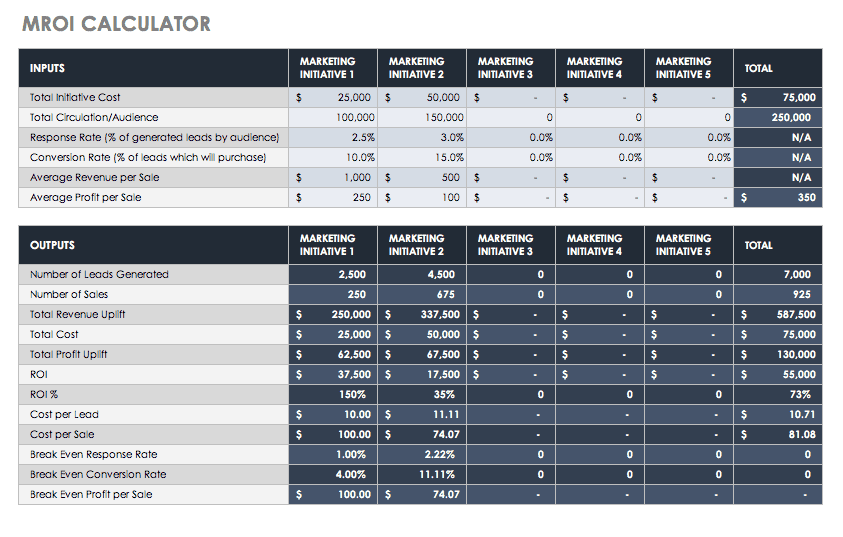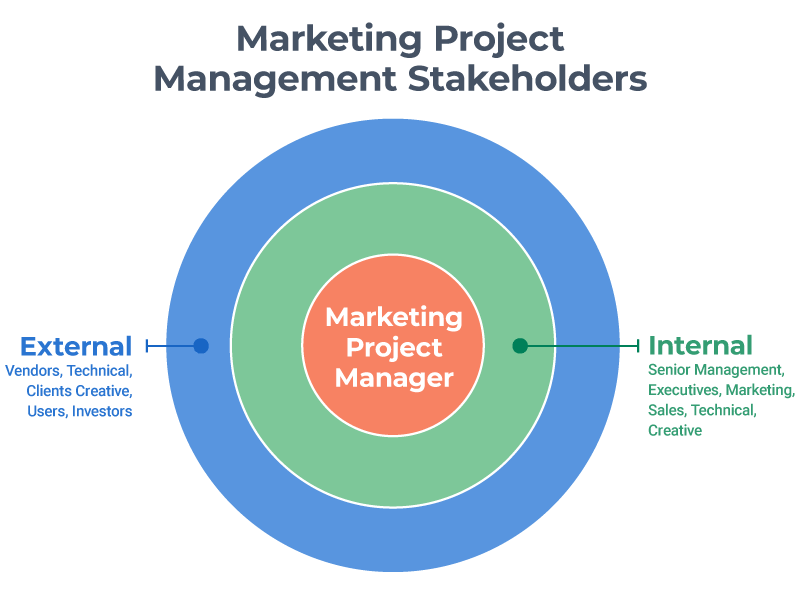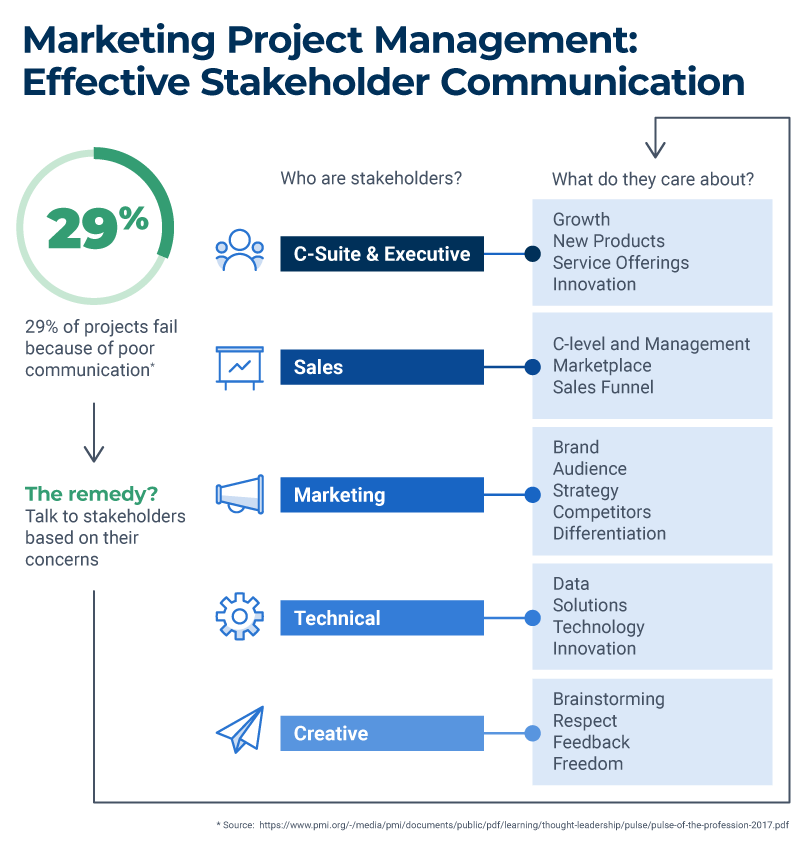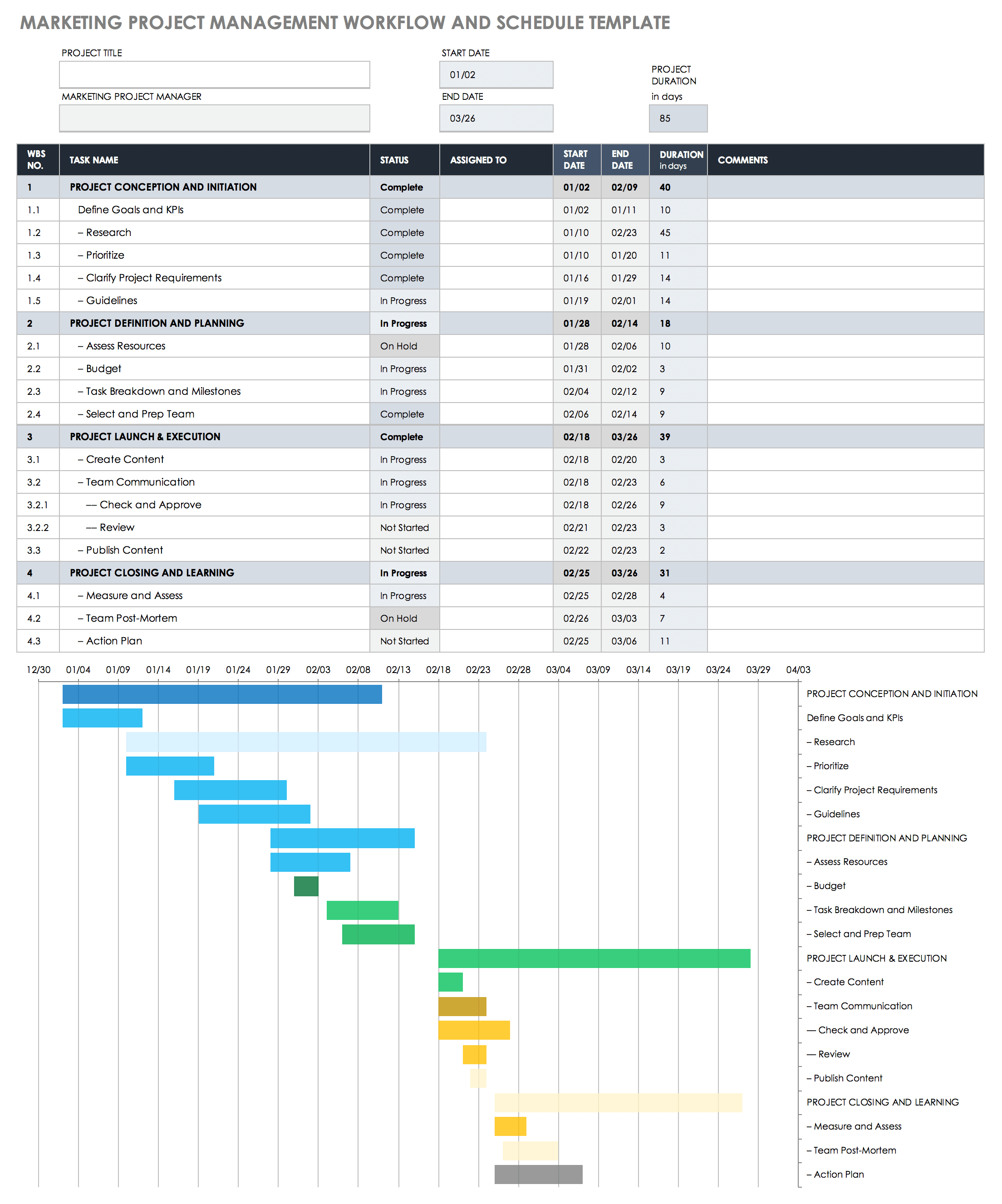What Is Marketing Project Management?
Marketing project management is a systematic process that covers all aspects of content administration and development, from concept to creation to completion.
Project management for marketing has become a necessity for both in-house marketing departments and agencies. “There are competitive pressures that drive the need to deliver results and shorten schedules,” says Fiona Remley, Global Advertising Leader for Worldwide Programs, Content, and Creative Operations with Amazon Advertising. “For example, my goals to reduce SLA [service level agreements between marketing and sales teams to drive revenue] timeframes have been cut by approximately 20 percent before 2021, the third reduction in the past five years. That’s the nature of the business now.”
Marketing Project Management Benefits
The primary benefit of structured marketing project management is that it sets specific goals and requirements — every task and activity focuses on maximum efficiency. Marketing project management’s guardrails reduce complexity, improve performance, and shorten timelines.
Cari Jaquet, Vice President of Marketing for BigPanda, observes that a lack of structure is a stumbling block to high performance for projects. “Marketers need to construct and administer the discipline that characterizes effective project management: clearly stating the objective, defining roles and responsibilities, and specifying deadlines. As they say, you can’t build the plane while you’re flying it.”
The C-suite often scrutinizes marketing projects. Despite their high profile, many such projects suffer from lack of organization. Implementing campaigns, digital projects, and other content deliverables is a “messy” business with lots of moving parts and players. This unruliness is precisely why marketing projects benefit from a unified solution (in the form of spreadsheets or project management software) that also satisfies your ultimate client.
The multiple benefits of project management for marketing teams include the following:
- Project Oversight and Organization: Effective marketing project management is all about ensuring every activity and stakeholder serves project goals in the most economical way possible.
- Optimized Team Communication: Stay in touch with everyone involved in the project so that you can understand current and potential roadblocks.
- Operational Excellence: With accountability measures in place, every team member sees the flow of value to the customer and where to repair that flow before it breaks down.
- Highest Use of Resources: Strive to get the most out of tools, technology, time, materials, team members, freelancers, and consultants.
- Increased Productivity and Shorter Timelines: Projects move forward faster when everyone functions with a single goal and streamlines tasks.
- Repeatable Methodology: Once you complete projects and gain historical information, data, and results, you can use what works best and discard the rest to create your own best practices.
- Provable ROI: At the end of every project, the marketing project manager should note ROI and what senior management uses to rate your project as a failure or success.
Marketing ROI Calculator Template
At the start of your project, define your metrics relative to KPIs (key performance indicators). Generate marketing ROI (MROI) by reporting content-generated revenue minus the cost of content production. In this template, you’ll find space for multiple marketing initiatives so you can compare their relative value.
Download the MROI Calculator Template - Excel
For a deeper dive into how to measure and communicate the value of your marketing campaigns, explore our article on how to prove marketing ROI.
Marketing Project Management Solves Common Challenges
Today, project management and marketing go hand in glove. Pros bring a combination of hard (expert knowledge) and soft (personal interaction and engagement) skills to execute work successfully and overcome the common challenges:
- Scoping and Budgets: Amazon’s Remley explains, “The scoping and the budget work-back conundrum is one of the great challenges of marketing project management. In an ideal world, clients bring you their business problem and ask you to help solve it. But it usually works the other way around, as most marketing clients know what they’re trying to achieve and have a budget, but may not know what business problem they’re trying to solve. You face the dilemma of delivering a square peg for the price of a round hole. The strategy is to work with the client to unearth the business problem and deliver a logical solution within the budget or negotiate a new one.”
Remley advises, “With a set budget, you work backward and meet the requested timeline. The logic of a constricted timeline is that sometimes you make more profit by delivering the end product faster.” - Clients and Creative Deliverables:
- Sonia Schechter, Marxent's Chief Marketing Officer, says, "Help stakeholders understand the timeline, turn around requests with urgency, and emphasize that changes are expensive and time-consuming. What I've learned after years of experience is that good-enough video is perfect for online purposes. When we give videos to clients or outside consulting firms for review, people want to finger paint all over them. It's exhausting, and the end product rarely ends up being superior or within budget. As a result, we're very crisp in our communication about feedback turnaround and the types of request changes that are covered/included with the video."
- New Product Development and Launch: A new product supports company business objectives, such as boosting revenue, beating the competition, or increasing market share. A new product and its launch involve the entire organization at some point. The process also usually includes outside vendors, as is the case with the multichannel integrated strategic campaigns that BigPanda's Jaquet runs."
With the interdependencies of integrated campaigns and their crossover teams, it's not necessarily a linear or four- or five-step process. For example, your marketing team may need to rework a web page after launch, so that you may take a slight step back. Even one missed milestone at any stage of a new product launch can lead to a domino effect with disastrous consequences. Remain vigilant, stay flexible, keep an eye on dependencies, and manage the process with a tool that provides good communication and document sharing, like Smartsheet or Asana." - Honoring Creatives: Most marketers have worked on a project with clients who think they can write copy, design, or act as an art director. Marxent's Schechter knows the problem well. Marxent is a 3D commerce and visualization company that produces explainer and other videos to use as a marketing tool and on behalf of clients. "Video projects are far more expensive and time-consuming to rework than other marketing projects," says Schechter. "People can now make videos on their phone or have a perspective they want illustrated. Everyone thinks that they are a genius at this stuff. To make schedules and budgets work, you must enforce expertise, rein in clients, and stop the changes."
Schechter adds, "The hardest, and yet most necessary, thing to do is to trust your creatives and stop yourself from requesting a slew of changes. Without fail, you'll see things that could (theoretically) make a video project better. However, you must be honest about which changes are truly worth the time, energy, and effort."
To avoid expensive alterations, Schecter suggests, "Provide your input and what you want for the project upfront — and document everything — so that you're not stuck haggling with the creative over details in post-production. If the team and its experts have clarity on requirements and documentation (e.g., a script, meeting notes), you can compare the final product to the original specifications, and it's less emotionally taxing for all."
Learn how to increase your organization's efficiency and improve results with Smartsheet's definitive “Project Management Guide.”
Digital Marketing Project Management
Digital project management is the oversight of planning, tracking, and deliverables of tech-centered projects generated and delivered online. Examples include digital marketing campaigns, mobile apps, website development, UI/UX designs, and conversion rate optimization.
Digital asset management (DAM) software makes digital projects possible and is part of project implementation, which organizes and stores media files and secures brand assets. DAM also supports team collaboration and file distribution, and often offers additional functionality, such as scheduling asset distribution.
If you’re thinking about purchasing DAM, find buying tips by reading “Expert Advice on Choosing the Digital Asset Management System That’s Right for Your Company.”
Who Uses Marketing Project Management?
A variety of stakeholders with an investment in a project’s success use marketing project management. They can be project managers, team members with assigned tasks, or organizations or individuals with approval powers.
Here’s a breakdown of the role of different marketing project stakeholders, whether they work in house or at an agency:
- Marketing Project Manager: The manager is ultimately responsible for ensuring team members stick to their tasks and deadlines, collaborate, and are held accountable to everyone on the team. In house, the project manager may be a marketing director, marketing manager, or other marketing staff members. At marketing or PR agencies, account managers or project managers may hold the title.
- Internal Stakeholders: In-house groups or individuals tasked with responsibilities to complete the project are internal stakeholders. Examples of internal stakeholders are senior managers, department executives, marketing staff, sales teams, and technical and creative professionals.
- External Stakeholders: Freelancers or vendors and suppliers, SEO specialists, web designers and developers, and copywriters working on a project are external stakeholders. Other external stakeholders can be customers, users, or investors.
“Learn how to speak the lingo of stakeholders as much as you can,” says Amazon’s Remley. “Trust and synergy are scaffolded with tailored communication skills.”
Marketing Project Management Skills
Marketing project management skills include strategic thinking, time management, effective leadership of cross-functional teams, problem-solving, task delegation, competent communication, negotiation, and organization.
Marketing Project Plans to Identify Specific Requirements and Goals
A marketing project plan provides a map of what’s necessary to complete a project. First, determine the overall marketing strategy, then describe the project, its goals, and estimated time to completion in the document.
For greater detail about how to develop your plan and project plan templates, see “Free Marketing Project Plan Templates.”
Marketing Project Management Workflows
Once you complete the project plan, organize the project process into workflows, which includes scheduling and process development.
Workflows map out task sequence. Scheduling organizes and shares activities, deliverables, and milestones within a project. The marketing project manager will share the document with team members/stakeholders when it’s most effective. Process development establishes a set of repeatable activities for accomplishing organizational goals in similar projects such as product launches, campaigns, or branding.
BigPanda’s Jaquet says that attention to process development has paid off for her team and the organization. “At this point, we just use our collaboration tools, and most of our projects go from start to finish with virtually no meetings at all,” Jaquet says with pride.
While marketing project workflows vary in detail depending on the type of project, team members, and budget, there’s a framework that should take your marketing project from start to finish. Here are the four phases of the marketing project management process:
- Concept and Initiation
Set out the project scope and related details. Many overall requirements will come from the marketing management project plan.- Define/Quantify Goals/KPIs: Set the metrics you and the team want to achieve.
- Research: Gather the necessary background information, including internal documents, sales projection, competitive landscape, or other factors that affect your project.
- Prioritize: Pinpoint priorities that will help you reach your goal.
- Clarify Project Requirements: What are the elements that need to be pulled together or executed to ensure success?
- Definition and Planning
Use the project scope to identify what it takes to create marketing content, including the resources needed.- Assess Resources: These include experts, internal or external team members, materials, technology, trades, or associations that need to be on hand.
- Budget: Create a work-back budget. When the budget doesn’t match requirements, it’s time to go back to your funder and ask for more financial resources or see where you can make changes.
- Break Project into Tasks: Evaluate the goal, resources, budget, and team, and then break everything down into assignments.
- Set Milestones: Set the time frames associated with each task and what’s necessary to meet specific achievements.
- Select and Prep the Team: Based on your recourse assessment and potential team, use the RACI (responsible, accountable, consulted, and informed) system to clarify individual or group roles for each task. For more information, look to “A Comprehensive Project Management Guide for Everything RACI.”
- Launch and Execution
Put your plan into action. During this stage, it’s vital that the project manager communicates thoroughly. The manager needs to know if completing a task or deadline is at risk or blocked, or if budgets are creeping out of control. Be aware of “scope creep” and restrain time and cost overruns with meticulous, daily oversight.- Create Content: Now it’s time to tackle the tasks associated with the project. The project manager oversees the work to be sure it gets done on time and budget. Take a deeper dive with “Content Marketing Project Management Toolkit: Workflows, Templates, and Checklists.”
- Communicate with the Team: While communication with team members is essential throughout all project phases, it’s particularly critical during the execution phase.
- Check and Approve: Review every task and milestone and ensure that all executive and legal approvals are complete.
- Review and Review Again: The final approvers should review all relevant materials, obtain signatures, make any needed changes, and perform one last review before delivering the project.
- Publish and Distribute Content: Based on your plan, disseminate the final project product.
- Closing and Learning
Conducting a post-mortem to analyze the outcome and determine what you can improve in future projects.- Measure and Assess: Review the project’s impact on your stated KPIs and goals.
- Team Post-Mortem: Ask for input from the team and compile a learning list.
- Action Plan for Follow-Ups and Improvements: Put together your own best practices guide to enrich your methodology.
Learn more by visiting our marketing workflow guide.
Marketing Project Management Workflow and Schedule Template
This customizable template provides a tracking tool for each phase of your marketing project. The model captures administrative details; lists each activity, start and end dates, responsible party, and duration; and provides a space for comments. The accompanying Gantt chart provides visual documentation of the progress of each phase and task progress, so you can track the project’s milestones.
Download Marketing Project Management Workflow and Schedule Template
Having the right tools to handle workflows and schedules, like project schedule templates, can help you minimize complications.
Best Practices and Expert Tips to Improve Marketing Project Management
Marketing project management best practices address areas that need improvement: efficiency, accountability, collaboration, and tools usage.
- Make the Most of Everyone’s Time: Your most precious commodity expands when everyone is mindful (or reminded) of its value.
- Limit Hours: Try to keep tasks to 80 hours or less. Tasks that exceed 80 hours are difficult to track and manage.
- Honor Timelines: Team members need to understand the timeline and treat turnaround requests with urgency.
- Drive Project Excellence with Accountability: Instilling a sense of responsibility within the group yields more satisfactory results.
- Enforce Check-Ins: Create a recurring check-in for both core/working teams and the other stakeholders.
- Define Ownership: Be clear about responsibility assignments from the beginning and use your tools wisely when alerting, scheduling, and assigning tasks.
- Balance Communications: Amazon’s Remley builds a communications plan tailored to each stakeholder for every project. Remley and BigPanda’s Jaquet recommend holding down the noise and avoiding inundating people with communications, specifically too many emails.
- Feed Creativity and Innovation with Collaboration: Respect every team member’s contributions and energy.
- Highlight Alignment: “Ensure everyone aligns on the end state: When this project is over, what does it look like? What are the key deliverables?” Jaquet advises. “At the highest level, everyone should understand dependencies and inter-connected work and product streams.”
- Cross-Functional Education: Educate cross-functional teams, functional managers, senior management, and any other stakeholders with quarterly newsletters or internal posts.
- Cultivate Champions: Develop champions who have clout in the organization and understand your challenges and goals.
- Empower Owners: Jaquet’s advice differs from general project management wisdom. She finds that when project deliverables and dates are defined by their owners, deadlines are typically met.
- Be Picky about Tools: Everyone needs to be comfortable with using project management tools and understand how to use them.
- Team Buy-In: “Agree with team members on the project toolset that best works for the organization,” Jaquet suggests. “Define which project visualization, like Kanban or Gantt, is preferred so you can build the underlying trackers correctly.”
- Follow the Best Examples: Publish and share with your team “best of breed” examples of deliverables, productive teams, and processes. “Chances are you can reuse something already developed for another client,” suggests Remley. “If you do leverage an existing tool or template, consider the core issue: does this solution answer the client’s central business challenge? Or have you just kicked the can down the road?”
Frequently, the tool that can get your team further, faster is project management software customized to fit your needs.
Learn more about what's required to deliver marketing projects on time and budget by reading about the macro and micro marketing project management skills to master in today's competitive climate.
Marketing Project Management Software
Marketing project management software is purpose-built to enable a unified, fast-paced approach to the creative work involved in marketing. The goal is to improve collaboration, transparency, time, and budget management.
Marketing project management software typically includes anywhere access from any device and customizable views. Some solutions are more elaborate and include time and traffic monitoring, customer relationship management features, and invoicing. All those options can make it challenging to select a just-right tool for your in-house department or agency.
For helpful buying guidelines, refer to “How to Pick Marketing Project Management Tools and Software.”
Improve Marketing Project Management with Smartsheet for Marketing
The best marketing teams know the importance of effective campaign management, consistent creative operations, and powerful event logistics -- and Smartsheet helps you deliver on all three so you can be more effective and achieve more.
The Smartsheet platform makes it easy to plan, capture, manage, and report on work from anywhere, helping your team be more effective and get more done. Report on key metrics and get real-time visibility into work as it happens with roll-up reports, dashboards, and automated workflows built to keep your team connected and informed.
When teams have clarity into the work getting done, there’s no telling how much more they can accomplish in the same amount of time. Try Smartsheet for free, today.







